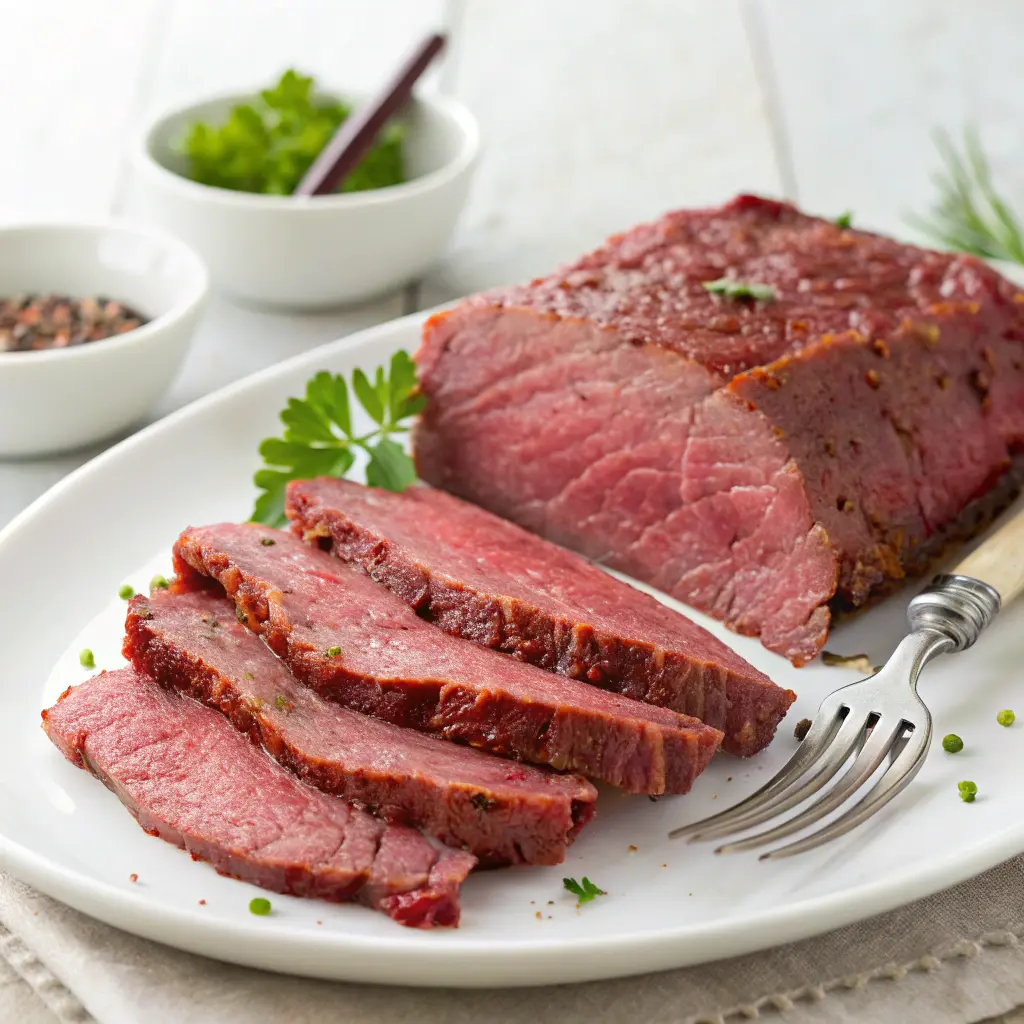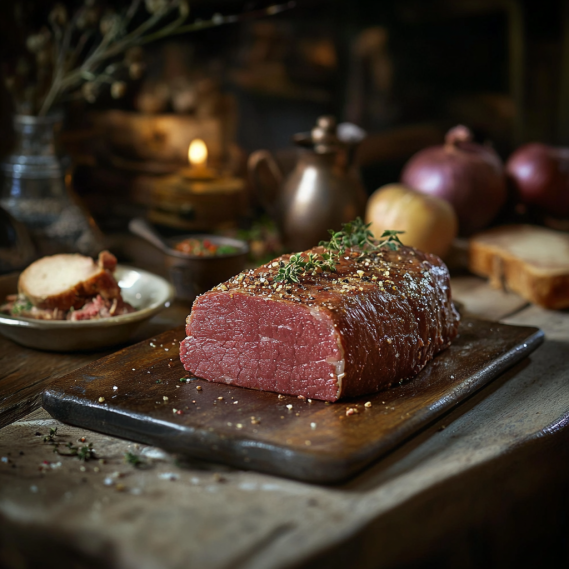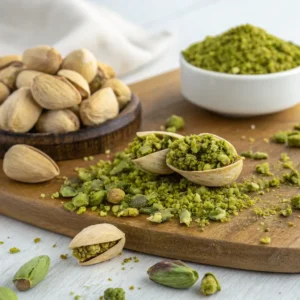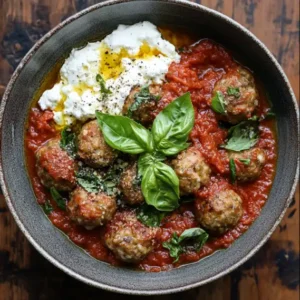What is Corned Beef?
You may have heard of corned beef, especially around St. Patrick’s Day, but do you really know what it is? Let’s dive into the world of this flavorful meat.
Corned beef is essentially beef brisket that has been cured in a salt brine. The term “corned” doesn’t actually refer to corn at all. It comes from an old English word for grain, which described the large grains of rock salt used in the curing process.
Fun fact: Corned beef has been around for centuries and has played a significant role in various cultures, from Irish-American cuisine to Jewish delicatessens.
The history is fascinating. It originated as a way to preserve meat before refrigeration was invented. The salt cure would keep the beef from spoiling, making it an invaluable food source for long journeys and military campaigns.
Today, you’ll find corned beef as a staple in many cuisines. It’s particularly popular in:
- Irish-American St. Patrick’s Day celebrations
- Classic Reuben sandwiches
- New England boiled dinners
Now that you know what corned beef is, let’s explore how it’s made.
Table of Contents
“How This Savory Dish is Made
The process of making corned beef is simpler than you might think, but it does require time and patience. Here’s a breakdown of how it’s done:
- Selecting the meat: Typically, a beef brisket is used. This cut comes from the lower chest of the cow and is known for its tough but flavorful meat.
- Preparing the brine: A salt solution is created, often with additional spices for flavor.
- Curing: The beef is submerged in the brine and left to cure for several days, usually 5-7.
- Cooking: After curing, the beef is rinsed and then cooked slowly until tender.
The Role of Spices
The spice blend used in corned beef is what gives it its distinctive flavor. Common spices include:
- Mustard seeds
- Allspice berries
- Coriander seeds
- Peppercorns
- Bay leaves
You can customize this blend to suit your taste preferences. Some people like to add garlic, cloves, or even cinnamon for a unique twist.
The Pink Color Mystery
Have you ever wondered why corned beef has that characteristic pink color? It’s not just from the curing process. The pink hue comes from the use of sodium nitrite, a curing salt that also helps preserve the meat and prevent bacterial growth.
If you’re concerned about using sodium nitrite, there are alternatives. Some recipes use beet juice to achieve a similar color naturally. However, keep in mind that this won’t have the same preservative effects as sodium nitrite.
Now that you understand the process, why not try making your own corned beef at home?
Curing Your Own Corned beef at Home
Here’s what you’ll need:
- 4-5 pound beef brisket
- 1 cup kosher salt
- 1/2 cup brown sugar
- 2 tablespoons pink curing salt (optional)
- 1 gallon water
- Your choice of pickling spices
Step-by-Step Instructions

- Mix the brine: In a large pot, combine the water, salt, sugar, curing salt (if using), and spices. Bring to a boil, then cool completely.
- Submerge the beef: Place the brisket in a large, non-reactive container and pour the cooled brine over it. Ensure the meat is fully submerged.
- Refrigerate: Cover and refrigerate for 5-7 days, turning the meat once a day.
- Rinse and cook: After curing, remove the beef from the brine, rinse thoroughly, and it’s ready to cook!
Pro tip: For the best flavor, toast your whole spices before adding them to the brine. This releases their essential oils and intensifies their taste.
Customizing Your Spice Blend
Don’t be afraid to experiment with your spice blend. Here are some ideas to get you started:
- Add a cinnamon stick for a subtle warmth
- Throw in some juniper berries for a gin-like flavor
- Include a few cloves of garlic for extra punch
Remember, the beauty of making your recipe is that you can tailor it to your exact tastes.
Cooking
There are several methods you can use:
Traditional Boiling Method
- Place the corned beef in a large pot and cover with water.
- Add additional spices if desired.
- Bring to a boil, then reduce heat and simmer for about 50 minutes per pound, or until tender.
Oven-Braised Corned Beef Brisket
For a slightly different approach, try this oven method:
- Preheat your oven to 350°F (175°C).
- Place the corned beef in a roasting pan with a cup of water or beer.
- Cover tightly with foil and bake for about 1 hour per pound.
- In the last hour, add vegetables like carrots, potatoes, and cabbage if desired.
Slow Cooker Method
If you prefer a set-it-and-forget-it approach:
- Place the corned beef in your slow cooker.
- Add enough water or broth to cover.
- Cook on low for 8-10 hours, or until tender.
Whichever method you choose, always let your corned beef rest for about 10-15 minutes before slicing against the grain.
Serving Suggestions
Here are some classic options:
- Colcannon: A traditional Irish dish of mashed potatoes with kale or cabbage
- Cabbage: Simply boiled or sautéed
- Carrots and parsnips: Add these to your cooking liquid for the last 30 minutes
- Irish soda bread: Perfect for soaking up the flavorful juices
For a twist on tradition, try serving your corned beef in a Reuben sandwich or chopped up in a hash with potatoes and eggs for breakfast.
Health Considerations
While delicious, it’s important to note that corned beef is high in sodium and fat. Here are some health considerations to keep in mind:
- Sodium content: Due to the curing process, corned beef is high in sodium. If you’re watching your salt intake, consume in moderation.
- Saturated fat: Brisket is a fatty cut of meat. Consider trimming visible fat before cooking.
- Nitrates: If using sodium nitrite, be aware that frequent consumption of cured meats has been linked to increased cancer risk.
To make a healthier version:
- Use a leaner cut of beef
- Reduce the salt in your brine
- Consider natural alternatives to sodium nitrite, like celery juice powder
Remember, corned beef can be part of a balanced diet when enjoyed in moderation.
Storing and Reheating Leftovers
Don’t let your delicious corned beef go to waste! Here’s how to properly store and reheat your leftovers:
Refrigeration
- Store in an airtight container or wrapped tightly in foil
- Consume within 3-4 days
Freezing
- Wrap tightly in freezer paper or plastic wrap, then in foil
- Label with the date and use within 2-3 months
Reheating Methods
- Oven: Wrap in foil and heat at 350°F (175°C) for about 20 minutes.
- Microwave: Place slices in a microwave-safe dish with a bit of liquid, cover, and heat in 30-second intervals.
- Stovetop: Slice thinly and reheat gently in a skillet with a splash of water or beef broth.
Personal tip: I like to slice my leftover corned beef thinly and use it cold in sandwiches. It’s delicious with Swiss cheese and sauerkraut on rye bread!
Corned Beef: Beyond the Basics
Now that you’ve mastered the basics of corned beef, why not explore some creative variations?
Global Inspirations
- Jewish-style: Serve with pumpernickel bread and spicy mustard
- Cuban-inspired: Use in a Cuban sandwich with ham, Swiss cheese, and pickles
- Asian fusion: Try it in fried rice or as a filling for dumplings
Leftover Ideas
Don’t let any of your corned beef go to waste. Here are some delicious ways to use up leftovers:
- Corned beef hash
- Corned beef and cabbage soup
- Corned beef tacos
- Corned beef quiche
The possibilities are endless when you let your culinary creativity flow!
Community Tips and Praise
Let’s hear from some home cooks who have tried their hand at making corned beef:
“I never knew homemade corned beef could taste so much better than store-bought! The flavor is incredible, and it’s so tender.” – Sarah K.
“Using beer instead of water in the cooking process added an amazing depth of flavor. Highly recommend!” – Mike T.
“I was nervous about curing my own beef, but your instructions made it so easy. It turned out perfect!” – Emily R.
These testimonials show that with a little patience and the right guidance, anyone can make delicious corned beef at home.
Embracing the Corned Beef Tradition
As we wrap up our journey through the world of corned beef, remember that this dish is more than just food. It’s a connection to history, a celebration of cultural traditions, and a delicious way to bring people together.
Whether you’re enjoying it as part of a St. Patrick’s Day feast, savoring it in a classic Reuben sandwich, or experimenting with new recipes, corned beef offers a world of culinary possibilities. So roll up your sleeves, gather your spices, and start your own corned beef adventure. Who knows? You might just start a new tradition of your own.
Frequently Asked Questions
- Q: Can I make corned beef without sodium nitrite? A: Yes, you can. The meat won’t have the characteristic pink color, but it will still be delicious. Some people use beet juice for color.
- Q: How long does it take to cure corned beef? A: Typically, it takes 5-7 days to cure corned beef in the refrigerator.
- Q: Is corned beef always made from brisket? A: While brisket is traditional, you can use other tough cuts of beef like round or chuck.
- Q: Can I cook corned beef in a pressure cooker? A: Yes, a pressure cooker can significantly reduce cooking time. Follow your cooker’s instructions for timing.
- Q: Why is my corned beef tough? A: Tough corned beef is usually undercooked. Make sure to cook it long enough to break down the connective tissues.
- Q: Can I cure corned beef without sugar? A: Yes, you can omit the sugar from the brine. It’s primarily used for flavor balance.
- Q: How do I know when my corned beef is done cooking? A: Corned beef is done when it’s fork-tender. A meat thermometer should read at least 145°F (63°C).
- Q: Can I make corned beef from other meats? A: While beef is traditional, you can apply similar curing techniques to other meats like pork or turkey.




